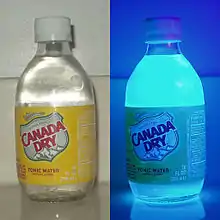Tonic water
Tonic water (or Indian tonic water) is a carbonated soft drink in which quinine is dissolved. Originally used as a prophylactic against malaria, tonic water usually now has a significantly lower quinine content and is consumed for its distinctive bitter flavor, though it is nowadays also often sweetened. It is often used in mixed drinks, particularly in gin and tonic.

History
Quinine powder is so bitter that British officials stationed in early-19th-century India and other tropical posts where medicinal quinine was recommended, mixed the powder with soda and sugar, and tonic water was created. The first commercial tonic water was produced in 1858.[1] The mixed drink gin and tonic also originated in British colonial India, when the British mixed their medicinal quinine tonic with gin.
Quinine content
Medicinal tonic water originally contained only carbonated water and a large amount of quinine. However, most tonic water today contains less quinine and is used mostly for its flavor, often enhanced by citrus flavors. As a result of the lower quinine content, it is less bitter, and is also usually sweetened, often with high-fructose corn syrup or sugar. Some manufacturers also produce diet (or slimline) tonic water, which may contain artificial sweeteners such as aspartame. Traditional-style tonic water with little more than quinine and carbonated water is less common but may be preferred by those who desire the bitter flavor.
In the United States, the US Food and Drug Administration (FDA) limits the quinine content in tonic water to 83 ppm[2] (83 mg per liter if calculated by mass), while the daily therapeutic dose of quinine is in the range of 500–1000 mg,[3] and 10 mg/kg every eight hours for effective malaria prevention (2100 mg daily for a 70 kg adult).[4] It is often recommended as a relief for leg cramps, but medical research suggests some care is needed in monitoring doses.[5] Because of quinine's risks, the FDA cautions consumers against using "off-label" quinine drugs to treat leg cramps.[6]
Use
Tonic water is often used as a drink mixer for cocktails, especially gin and tonic. Vodka tonic is also popular. Tonic water with lemon or lime juice added is known as bitter lemon or bitter lime, respectively.
Fluorescence
The quinine in tonic water will fluoresce under ultraviolet light. In fact, the sensitivity of quinine to ultraviolet light is such that it will appear visibly fluorescent in direct sunlight against a dark background.[7][8]
See also
References
| Look up tonic water in Wiktionary, the free dictionary. |
| Wikimedia Commons has media related to Tonic water. |
- Raustiala, Kal. "The Imperial Cocktail". Slate. The Slate Group. Retrieved 30 August 2013.
- "21 CFR §172.575 Quinine" (PDF). Retrieved 15 December 2008.
- "Quinine". Tropical Plant Database. Section "Current practical uses": Raintree Nutrition. Retrieved 10 July 2011.
- Achan, J (2011). "Quinine, an old anti-malarial drug in a modern world: role in the treatment of malaria". Malaria Journal. 10 (144): 1–12. doi:10.1186/1475-2875-10-144. PMC 3121651. PMID 21609473.
- Brasić, JR (1999). "Should people with nocturnal leg cramps drink tonic water and bitter lemon?". Psychol Rep. 84 (2): 355–67. doi:10.2466/pr0.1999.84.2.355. PMID 10335049. S2CID 42278918.
- United States Food and Drug Administration (11 December 2006). "FDA Orders Unapproved Quinine Drugs from the Market and Cautions Consumers About Off-Label Quinine to Treat Leg Cramps". Archived from the original on 13 January 2017. Retrieved 26 April 2017.CS1 maint: bot: original URL status unknown (link)
- Steve Fentress (9 August 2011). "The Blue Glow Of Quinine". indianapublicmedia.org. Retrieved 16 February 2020.
- Suzanne Elvidge (24 August 2012). "Seeing Ultraviolet Light: Tonic Water in Sunlight". Science Project Ideas. Retrieved 16 February 2020.
